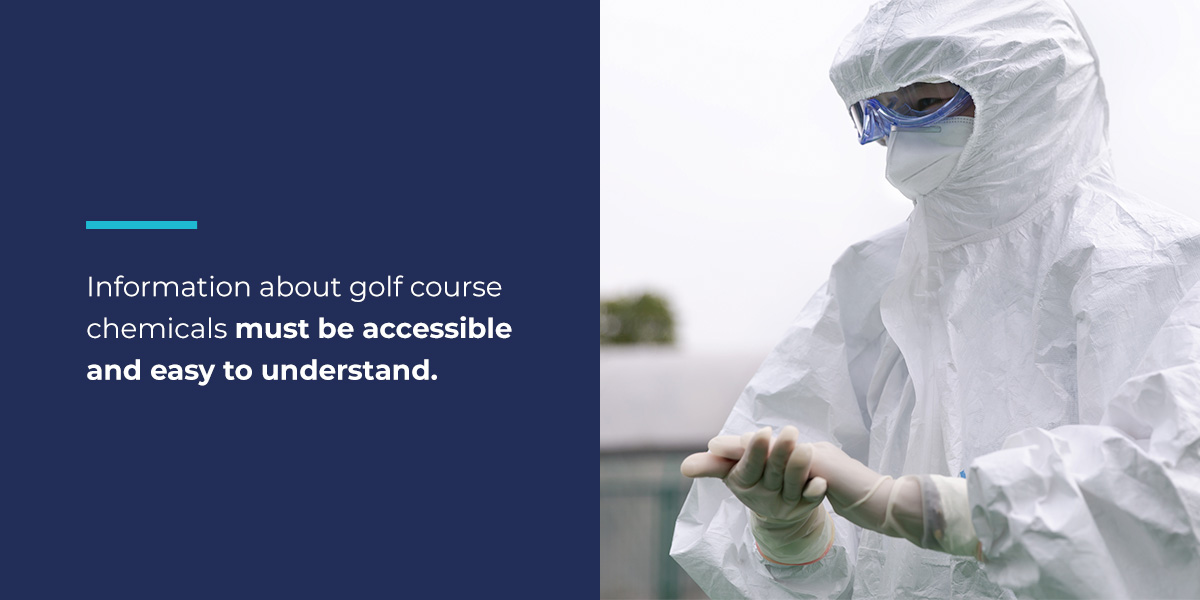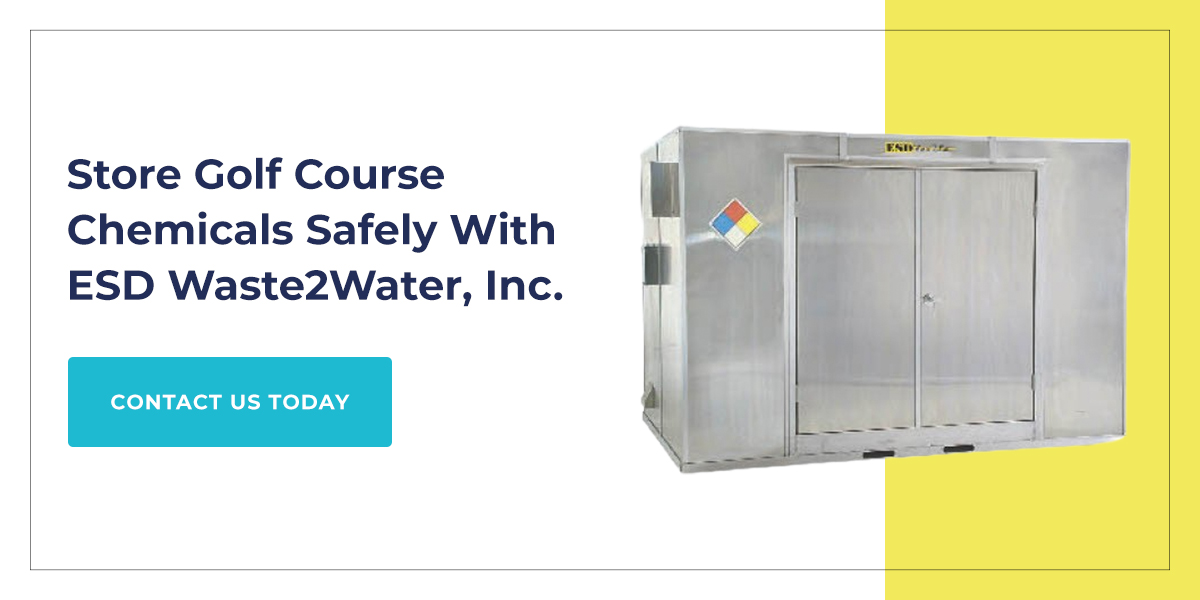
Golf course greens and fairways provide an attractive landscape for golfers to swing some golf clubs and try for a hole-in-one. However, golf courses require pesticides, fertilizers and other chemicals to maintain this appearance, which can be hazardous. Golf course chemical usage and storage help keep guests and employees safe, while protecting the environment from pollution.
Golf course superintendents must follow all regulations when handling and storing chemicals. Storage, appropriate handling procedures, chemical training, regular inspection and proper ventilation can go a long way toward ensuring golf course safety.
The Importance of Safe Golf Course Chemical Storage
Proper chemical storage is paramount to golf course safety. Correct chemical use and storage prevents potential explosions, chemical burns, property damage, fires, injuries, illness and pollution. It’s also illegal to neglect these best practices.
The Environmental Protection Agency requires golf course managers to follow pesticide storage regulations. For example, groundskeepers must store agricultural pesticides in containers that can hold 500 gallons or more. Observing standards ensures golf course operations comply with federal, state and local laws. Additionally, the Golf Course Superintendents Association of America passed a rule that requires golf courses to store their chemicals in appropriate containment units.
Common Golf Course Chemicals
Golf courses offer guests a beautiful and tranquil setting, and this environment requires chemicals to maintain its appearance. The pest-free, pristine greens and spotless fairways that make golf courses so gorgeous require fertilizers, pesticides, fungicides and herbicides to remain so visually appealing. These hazardous chemicals require appropriate storage.
Granular and liquid fertilizers are popular for golf course maintenance and contain potassium, phosphorus and nitrogen. Golf course janitorial and maintenance teams also use chemicals such as cleaning and disinfecting agents to maintain buildings.
How to Keep Golf Courses Safe
Keeping a golf course safe protects guests, employees and the environment from potential hazards. Golf course managers can protect people and the environment with the following golf course safety tips.
Store Pesticides Properly
Chemical storage keeps hazardous elements from spilling or interacting with other materials. To properly store golf course chemicals, grounds managers can consider the following tips:
- Store products off the floor.
- Store dry materials above liquid materials to prevent liquids from leaking onto dry chemicals.
- Keep the spill containment kit updated.
- Discard empty storage containers promptly and safely.
- Mix and store chemicals away from groundwater supplies to prevent leaks or spills from entering rivers, ponds and lakes.
- Store aboveground tanks in a containment unit to contain potential leakage.
- Install concrete-filled metal posts or other vehicle protection if any chemical tanks are near traffic.
Using high-quality golf course chemical storage units can help golf course managers maintain their hazardous material inventory. With a quality chemical storage facility, grounds managers can prevent chemical spills and reduce cross-contamination risks.
Train Employees

The United States Occupational Safety and Health Administration issued the Hazard Communication Standard to ensure employers inform their employees about chemical hazards. Information about golf course chemicals must be accessible and easy to understand.
Display a safety data sheet for each hazardous material in visible locations and train employees on how to prevent potential health hazards. Golf course managers can provide a hazardous material training course for new employees and an annual refresher course for current employees. It’s also crucial to ensure a golf course’s maintenance crew follows federal, state and local regulations.
Inspect Chemical Containers Regularly
Golf course managers should routinely inspect their chemical storage facility to check for any chemical container damage, which might cause leaks that lead to further issues such as potential chemical spills, chemical exposure or explosions. Preventive inspections can help avoid storage risks.
Inspect the Heating, Ventilation and Lighting Systems
Poor ventilation can cause gases to build up, harming the environment when released. Additionally, poor ventilation can transform a chemical storage facility into a toxic setting for employees who enter it. Regularly inspecting the heating, ventilation and lighting systems can ensure a storage facility is a safe place to work.
Keep Track of Chemical Product Inventory
Keeping track of chemical inventory can prevent potential hazards. To maintain an updated list of all hazardous materials, store similar chemicals together and correctly label each container. Golf course managers can designate one employee to oversee these tasks.
Handle Hazardous Materials Properly
Direct skin contact with golf course pesticides and fertilizers can pose health risks, so proper chemical handling is crucial. When guests use the golf course, they could directly contact chemical residue on the course’s turf and experience health complications. Golf course chemicals are also hazardous to the environment, so correctly handling chemicals protects the surrounding land and air from pollution. Consider the following safe chemical handling tips:
- Avoid spraying chemicals on the course when there is high wind.
- Follow storage, mixing and disposal regulations.
- To limit chemical use, pay attention to turf health and environmental factors such as plants, soil, insects and water proximity.
- Only use chemicals as directed on their containers. Applying more of a product than necessary does not mean it will work more effectively, and using too much of a chemical can release harmful amounts into the environment.
- Use the correct spray equipment for each liquid chemical, and maintain equipment to keep it in good condition.
- Apply chemicals early in the morning to reduce remaining residue when golfers arrive.
- Post signs to inform golfers and guests of a recent chemical application to ensure they don’t come in contact with harmful materials.
Store Golf Course Chemicals Safely With ESD Waste2Water, Inc.
Proper chemical storage is one of the best ways to keep a golf course safe. Chemical spills, cross-contamination and direct skin exposure to hazardous materials can lead to health complications, structural damage, environmental harm, fires or explosions. Correctly storing fertilizers, pesticides, herbicides and fungicides can reduce these potential risks and keep golf course guests and employees safe.
The best way to practice safe chemical storage is to keep hazardous materials in secure storage containers. ESD Waste2Water, Inc. provides chemical storage buildings specially designed for the turf care industry.
At ESD Waste2Water Inc, we fabricate chemical storage buildings with marine-grade aluminum to prevent rust, so they do not require frequent painting. Their design prevents cross-contamination and allows for an easy cleaning process. Contact us today to learn more about how we can help companies maintain golf course chemical safety.


